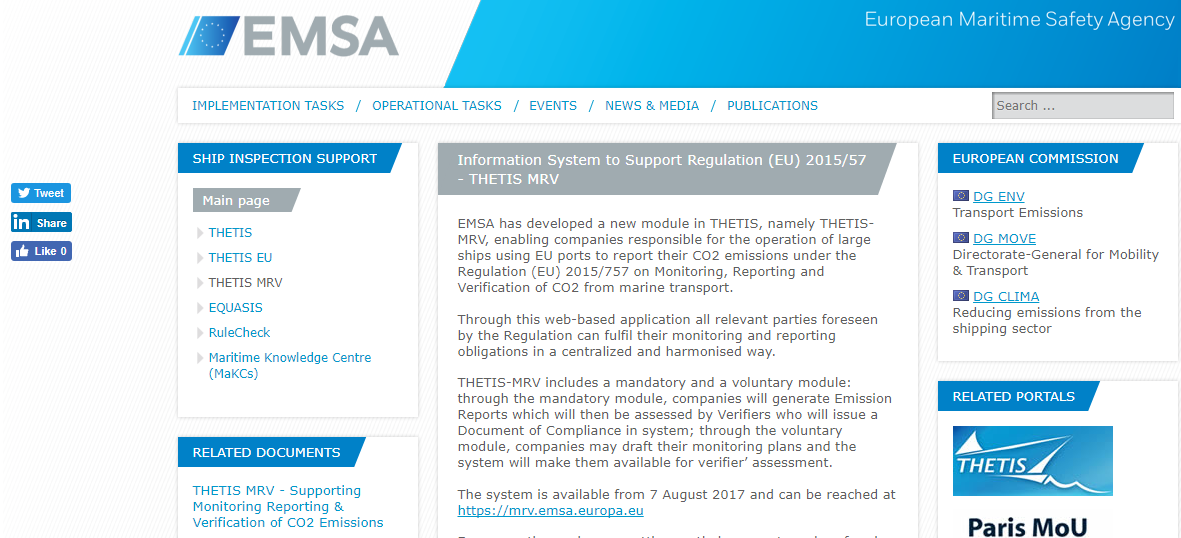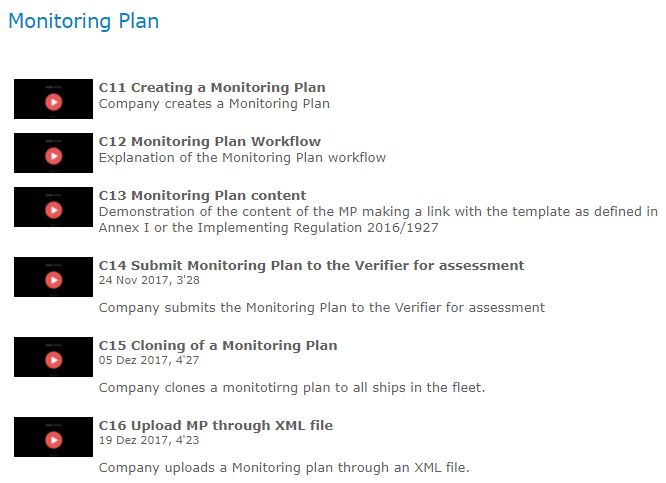THETIS Platform
THETIS platform is made available to companies and accredited verifiers so that they can use it to electronically submit to the commission and flag states the reports and the relevant compliance documents. THETIS is designed flexibly to form a global system for Monitoring, Reporting, and Verification (MRV) of greenhouse gas emissions (GHG). In order to access the platform, each user must log in to the website.

As mentioned before THETIS can be used either by companies or accredited verifiers. Before verifiers can use THETIS – MRV to assess Monitoring Plans (MPs) and verify Emission Reports (ERs), there are a couple of configurations which have to be done in the following sequence:
- Apply for an account registering as a verifier user;
- Enter verifier company details;
- If necessary, add new users under the same Verifier account;
- Define email notification as deemed appropriate;
- Enter Accreditation details to be confirmed by the System Administrator;
- Wait that System Administrator confirms the accreditation details;
- On success, wait that companies request a partnership;
- On success, wait that companies assign the accredited verifier to each ship where verification activities will be required.
In the same way, before companies can use THETIS – MRV to draft Monitoring Plans (MPs) and produce Emission Reports (ERs), there are a couple of configurations which have to be done in the following sequence:
- Apply for a registration as a company user;
- Enter MRV company details;
- If necessary, add additional users under the same Company account;
- Define email notification as deemed appropriate;
- Request a partnership to a Verifier;
- Wait that the verifier accepts the request;
- Add ship under the scope of the regulation;
- Update missing mandatory ship particulars.
Users of the company can create MPs for each ship and later submit them to the Verifier for assessment. Users will also be able to enter CO2 emissions (by recording fuel consumption or direct monitoring) in view of generating Emission Reports following each reporting period. For companies, the first data to be submitted is the company details, such as name, number, address, person of contact.
Once established and accepted a partnership with an accredited independent verifier (which can be seen in the field “Email Notifications” by the message; “Verifier is informed that Company requests a partnership to a verifier”), the company can further add vessels to their fleet. The company fills the gaps related to shipping particulars such as IMO number, vessel’s designation, type, flag, gross tonnage, deadweight, home port and port of registry, Classification Society and Ship owner’s name. Once this information is filled, the company can update a Monitoring Plan for each of its vessel’s. For that effect on the separator “My Fleet” and for each vessel go to “Actions” and select “Edit”.
In this section, the user can find information that was previously submitted (related to the ship and company data). Nevertheless, more specific information related to the vessel’s procedures, methodologies used on board, types of equipment, materials and fuel types used, need to be added to the Monitoring Plan. In the separator MP Particulars, there is a resume of the date of creation of the plan and also an updated status of the Monitoring Plan (it starts as a “draft” version, further is “submitted” to the verifiers’ appreciation and once validated the status changes to “assessed”).
In the Monitoring Plan of the Vessel must comprise the Measuring Equipment used on board, the indication of where it is applied and a technical description. The company must describe the emissions sources used on board and the potential fuel types to be used, and connect them to a measuring equipment. The level of the uncertainty associated with the measurement must be specified in %. In that separator the Monitoring Method used by the ship must be chosen among the 4 possibilities described on Regulation 757/2015, Annex 1:
- Method A: BDN and period stock take of fuel tanks;
- Method B: Bunker fuel tank monitoring on board;
- Method C: Flow meters for applicable combustion processes;
- Method D: Direct CO2 emissions measurement. The company must specify a connection between each fuel type and each tank used on board. For each fuel type, the correspondent emission factor must be indicated in order to calculate the emitted CO2 tonnes.
In the vessel’s monitoring plan also the detailed procedures used in terms of the determination of fuel consumption must be indicated (bunkered, in tanks, regular cross-checks made and how data gaps are treated. In each procedure the formulae used, data sources, the location where records are kept and the name of IT system used must be specified and in accordance with the Monitoring Plan. There is also a field in the Monitoring Plan related to the navigation of the ship and cargo carried. Procedures related to how the regular check of the adequacy of the MP is guaranteed, how quality and reliability of information is maintained, how corrections and reviews are made and how documentation is controlled must be described in the Monitoring Plan.
There is a Field to attach any documents if needed and a separator where all non-conformities detected are listed for further correction. Once the company considers all information to be correct, one may send it for validation by pressing “Submit to Verifier”. The Status of the MP revision can be consulted a long time in “MP Revision” until its assessment. THETIS platform has among a complete list of videos, one that explains in detail the MP workflow.
In terms of use the platform for accredited verifiers, it is similar, with the difference that the Monitoring Plan will only be available to this entity when sent for approval by the contractual binding client. On “My Fleet” the verifier can easily access the information of the vessels introduced by the company. By going to “Actions” in each vessel, the verifier can visualize the ship information, access the Monitoring Plan and the Emissions Report.
The validation of the Monitoring Plan is an interactive process since any non-conformity detected by the verifiers is communicated to the company for revision. The companies could request any review of the Plan as desired, until the end of the period 31st Dec. 2017 (and subsequently in the following years, if necessary, according to the legislation procedures). Once the MP is assessed, it can be visualized and downloaded. In the pdf document generated will be indicated that the Plan was assessed in accordance with EU Regulation 2015/757, by the accredited MRV verifier, its version and date, and the status.
During 2018 (until 31st Dec. 2018) companies will gather information regarding fuel consumption, CO2 emissions, ships activity (transport work, time at sea, distance travelled and cargo carried) and energy efficiency parameters. This information will be reported into the THETIS platform and comprise the Emissions Report information. Until 30th Apr. 2019, companies must submit a satisfactory verified emissions report to the EC and Flag State. MRV verifiers are to indicate that the report has been satisfactory and in conditions for issuing a Document of Compliance to be fulfilled. The Platform has also a set of videos, in particular, one that explains in detail the Emissions Report workflow.
From what we have seen previously we can surely say that EMSA has developed a useful and very user-friendly platform, in which both company members and independent accredited verifiers can work together, in order to overcome the requirements of the legislation.
THETIS has also an FAQ section in which questions are sent to EMSA. In order to resume the interaction and responsibilities of both parties involved in the MRV process, we conclude this brief explanation with a vídeo describing an exemplification case-study.





